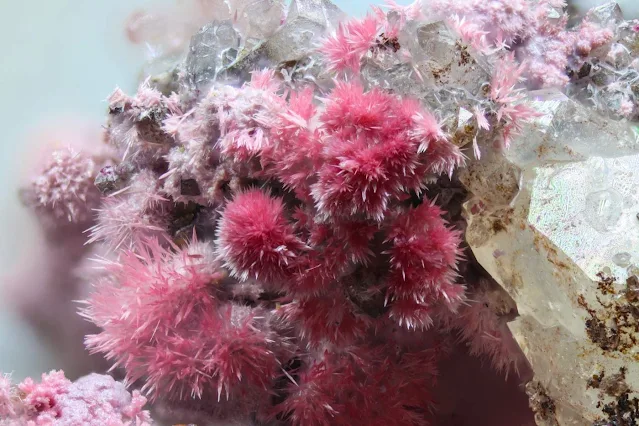Erythrite Crystals
Erythrite, also known as red cobalt, is a secondary hydrated cobalt arsenate mineral with the formula Co₃(AsO₄)₂·8H₂O. It's a member of the vivianite group and forms a complete solid-solution series with annabergite (nickel arsenate). This means that the two minerals can mix and match their cobalt and nickel atoms, creating a range of colors from crimson red to pale green.
Erythrite occurs as a secondary mineral in the oxide zone of Co–Ni–As
bearing mineral deposits. It occurs in association with cobaltite,
skutterudite, symplesite, roselite-beta, scorodite, pharmacosiderite,
adamite, morenosite, retgersite, and malachite.
Erythrite was first described in 1832 by François Sulpice Beudant and named after the Greek word "erythros" meaning "red."
Erythrite Properties
Chemical Formula: Co₃(AsO₄)₂·8H₂O
Color: Crimson red to pink, also found in purple, peach, and gray. Lighter colors indicate higher nickel content.
Crystal System: Monoclinic, typically forming prismatic crystals (rare) or crusts, aggregates, and needle-like formations.
Hardness: 1.5 - 2.5 on the Mohs scale (soft, easily scratched)
Luster: Subadamantine, pearly on cleavages
Streak: Pale red to pink
Diaphaneity: Transparent to translucent
Solubility: Soluble in acids
Occurrence: Secondary mineral found in oxide zones of cobalt-arsenic deposits, often associated with cobaltite, skutterudite, and native silver.
Historical Use: Indicator mineral for cobalt and silver deposits, but not economically important itself.
 |
| Erythrite. Photo: Henk Smeets/Tomeik Minerals. |
Where is Erythrite found
Erythrite is a secondary mineral, meaning that it forms from the weathering of other cobalt-bearing minerals. It's typically found in the oxidized zone of cobalt-nickel-arsenic deposits. Some notable localities for erythrite include:
- Cobalt, Ontario, Canada
- La Cobaltera, Chile
- Schneeberg, Saxony, Germany
- Joachimsthal, Czech Republic
- Cornwall, England
- Bou Azzer, Morocco
- Blackbird mine, Lemhi County, Idaho
- Sara Alicia mine, near Alamos, Sonora, Mexico
Toxicity: Erythrite contains arsenic, so handling should be done with care. It's recommended to wash hands after touching specimens to avoid arsenic exposure.
Uses: While not economically significant for mining cobalt, erythrite is prized by collectors for its beautiful color and as an indicator mineral for more valuable minerals nearby. It's also used in educational settings for its visual appeal and to teach mineralogy.



%20(1).webp)





